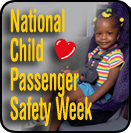One in Three Parent Drivers Puzzled by Child Passenger Restraints, According to GMAC Insurance
 |
Leading Insurer Offers Safety Tips in Observation of National Child Passenger Safety Week, Sept. 16-22
ST. LOUIS, Sept. 5 -- Today GMAC Insurance announced survey results revealing that, when it comes to properly restraining their children in vehicles, many parents are in the dark. Specifically, the survey found that approximately one in three licensed parents could not correctly identify that a child must be both at least one year old and at least 20 pounds before being placed in a forward-facing car seat.
The drivers who answered incorrectly are certainly not alone; Safe Kids Worldwide reports that nearly 73 percent of child safety seats and booster seats are used improperly. These statistics are particularly concerning considering that in a crash, child safety seats reduce fatal injury in passenger cars by 71 percent for infants less than one year old and by 54 percent for toddlers one to four years of age.
"As adults, we have a responsibility to ensure that children are safe at all times, and we can't leave safety in and around vehicles out of that equation," said Gary Kusumi, CEO and president, GMAC Insurance. "Even though there are many government and private initiatives to address child passenger safety, this survey shows that more must be done to educate parents and caregivers."
Kusumi points out that while infant safety typically receives greater focus when dealing with child passenger safety, this age group is not the only concern. "According to the National Highway Traffic Safety Administration (NHTSA), only 41 percent of children ages four to eight are riding in booster seats."
"Very often we let the older children who still need our attention slip through the cracks," Kusumi said. "Because many state laws only require children up to four to be in a car seat, many parents assume their older children are safe in just a seatbelt. That just isn't the case. Most children under the height of 4'9" and between 40 and 100 pounds usually need to use a booster seat to be properly restrained."
Buckling Down On Child Passenger Safety
While laws on child passenger restraints vary by state, Safe Kids Worldwide's Safe Kids Buckle Up program offers the following tips and guidelines for parents to follow in selecting the right type of seat for their child. According to the organization, using the correct restraint isn't about the age of a child, it's a combination of the child's height, weight and how he or she fits into a vehicle. What's more, every car seat and booster seat is different, and caregivers must always understand the seat's instructions.
Child Passenger Restraint Guidelines
If My Child Is... Type of Child Restraint
Under 1 year old and less Rear-facing seat- keep
than 20 pounds at a minimum child rear-facing as
long as seat allows
for maximum safety-
usually up to 30 pounds
At least 1 year old and 20 Forward-facing seat
to 40 pounds with a harness- use
until harness is
outgrown for maximum safety
Under 4'9" and Booster seat
approximately 40 to 100 pounds
Taller than 4'9" and more Safety belt, but
than 80 to 100 pounds remain in back seat
until age 13 until age 13
* Choose wisely. The NHTSA's 2007 Child Safety Seat Ease of Use Ratings
compares 101 child safety seats (including booster seats) to allow
parents to find the child safety seat that will best fit their needs.
Visit http://www.nhtsa.gov/CPS/CSSRating/Index.cfm to find which safety
seat is right for your child.
* Read up. To ensure that you install your specific car seat model
properly, make sure to read both the vehicle owner's manual and the
child safety seat instruction manual.
* Get inspected. As part of their Buckle Up program, Safe Kids Worldwide
and GM and Chevrolet car dealerships around the country sponsor child
safety seat inspections where caregivers can learn how to correctly
install their child's seat. Visit http://usa.safekids.org/ for upcoming
Safe Kids inspection events near you.
* Stay in the back. As a rule of thumb, all children under age 13 should
always be properly restrained in a rear seat.
* Restrain yourself. To encourage positive habits in your children, use
a seat belt yourself on every trip. In a recent Safe Kids Buckle Up
study, nearly 40 percent of children riding with unbelted drivers were
completely unrestrained, compared with only 5 percent of children
riding with belted drivers.
The GMAC Insurance survey was administered by TNS, a leading market information resource and the world's largest provider of custom research and analysis. The national sample was comprised of 5,175 total licensed respondents, aged 16-60+, balanced to the latest U.S. Census data. Of the 5,175 total respondents surveyed, an estimated 3,625 respondents had children. For more information about TNS, please visit www.tns-us.com.
For more information about GMAC Insurance and to find a local independent agent, call 877-468-3466 or visit www.gmacinsurance.com.
The GMAC Insurance Group is one of the largest automobile insurers in the United States and is a wholly owned subsidiary of GMAC Financial Services. GMAC Insurance Personal Lines offers a variety of property and casualty products, including personal auto, RV, motorcycle, commercial auto and homeowners insurance. With a nationwide network of claims professionals, local independent agents and a 24-hour, toll-free claims hotline available 365 days a year, GMAC Insurance provides superior claims service for its customers.


